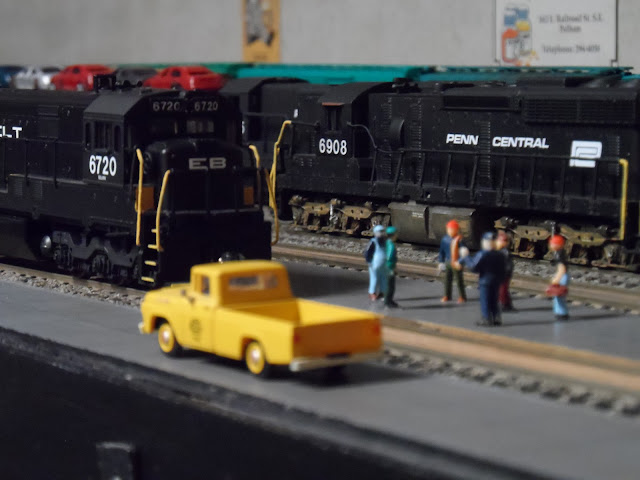Greetings All,
Welcome Back to Penn Central Car Movements #106!!!
PCCM 106 a one weekend three layout virtual op with my layout interchanging freight traffic with Sir Neal's Atlantic Pacific RR and PC Ralph's Kings Port Division concludes today with the arrival of a steel products train from Kings Port Steel and the interchange of this train with the Long Island RR.
The action starts today in Empire City with the EBRR trainmen watching Extra 4348 from Selkirk come thru town on its way to Terminal Yard.
Extra 4348 rolls into Terminal Yard.
FP7s 4348 and 4369 join their brethren in the engine terminal.
The Extra 4348 freight consist has been inspected and the engines are coupled on for movement to North Side yard as Train EC-1 but the guy's attention is drawn to the right.
The Extra 4348 freight consist has been inspected and the engines are coupled on for movement to North Side yard as Train EC-1 but the guy's attention is drawn to the right.
Here's what has drawn their attention!
Back to the PCCM action PC Train EC-1 is on the move thru Bedford.Train EC-1 arrives in North Side Yard.
Let's enjoy a close up of this good looking steel products train from Kings Port Steel as it arrives in North Side Yard.
Alco Joe and Conductor Murray check in with the EBRR guys.
Alco Joe and conductor Murray head back to Terminal Yard caboose lite as Train EC-2.
A little while later Long Island RR Train MA-3 from Fresh Pond Yard to North Side Yard rolls into Bedford, NY.
LIRR Train MA-3 heads to Empire City via the Bedford Secondary
Train MA-3 arrives in North Side Yard.
LIRR engineer Jimmy Alco checks in with the Empire Belt gang from the cab of his Alco C420 as he moves to couple up to the Kings Port Steel products train.
LIRR Train MA-4 is ready to depart North Side Yard with a long train of Kings Port Steel!!LIRR engineer Jimmy Alco checks in with the Empire Belt gang from the cab of his Alco C420 as he moves to couple up to the Kings Port Steel products train.
LIRR Train MA-4 departs North Side Yard.
The MA-4 rolls thru Bedford.
Train MA-4 heads to Fresh Pond Yard.
Put it in the books!!!
This concludes the PCCM 106 operations on the NYCTL. Be sure to catch all the action on Sir Neal's Atlantic Pacific RR and PC Ralph's Kings Port Division.
Thanks for reading and watching!!!
See you soon!!!




































































